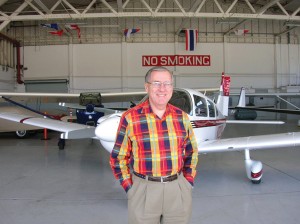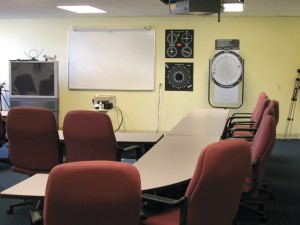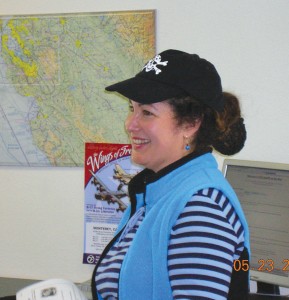By S. Clayton Moore
A small fixed base operation in California is creating what might be the perfect combination of expertise and customer service. Monterey Bay Aviation, led by an ambitious owner and staffed with a team of talented flight instructors, is building up a robust, gregarious community of aviators that value camaraderie as much as they value the wonders of flight.

Students at Monterey Bay Aviation will not only enjoy the company’s first-class facilities but also the warm California sunshine.
The FBO, located at Monterey Peninsula Airport (MRY), was formerly known as Del Monte Aviation and has been in existence since 1952. Located in the stunning seaside community that inspired John Steinbeck’s “Cannery Row,” Monterey Bay Aviation is approaching its customers with the same affection for people present in the great writer’s books.
That warmth is palpable during the FBO’s monthly meetings, dubbed “Red’s Mornings.” During the sessions, held early in the morning on the last Friday of every month, aviators young and old gather to share safety information, learn new tricks and reminisce about their flying histories. The big draw is hot donuts and coffee from Red’s Donuts, which has turned out the best pastries in northern California since it was founded in 1950.
“There’s such a sense of giving with these pilots,” said Donna Brady, director of sales and marketing for Monterey Bay Aviation. “Pilots are a very communal bunch but flying is a pretty solitary endeavor much of the time, so to speak with others and get their take on different aspects of flying can be very useful. Our ‘Red’s Mornings’ just add a little structure to a vibrant community of pilots.”
By focusing on building their local community, creating better training methodologies and making aviation fun, Monterey Bay Aviation is setting a glowing example for other operations. Its owner is even considering expanding by acquiring more fixed base operations around the region, making this operation the crown jewel of a string of first-class aviation operations.
Leading the charge
Brig. Gen. John M. Lotz is the owner, president and chief pilot of Monterey Bay Aviation. His vibrant and diverse career has included stints as an air traffic controller in the U.S. Navy, seven years in the U.S. Air Force as America was gearing up for Vietnam, and nearly 30 years in the California Air National Guard.
“I believe in training and I saw here the need to train a lot of people,” he said. “Doing aviation training in the area I love is a wonderful opportunity.”
Lotz learned to fly while growing up in the Southern California community of Riverside, where two of his uncles were pilots. With the draft underway, he joined the Navy, where he worked as an air traffic controller until his eyesight disqualified him.
Along the way, he built a small, unofficial Air Force flying club in Madison, Wis., into a successful flight school, giving him his first exposure to business. That experience led him to Harvard Business School, where he earned an MBA.

Monterey Bay Aviation is home to dozens of area aircraft as well as its own fleet of two Cessna 172s, a Piper Arrow II and a Citabria.
“It was clear to me that our poor men and women in the military weren’t getting enough credit in industry for all the experience they had in leading organizations and all the skills that most civilians don’t have,” he explained. “I decided that an MBA would be a good stepping stone into business.”
In fact, when it came time to finish his thesis, he chose fixed base operations as his primary subject. The document, “FBOs: An Industry In Transition,” served as the blueprints for his future business interests.
“It was basically a roll-up plan to manage multiple FBOs,” Lotz said. “An engineer friend of mine and I wrote three volumes around the thesis that dissected the various components of the general aviation industry.”
Lotz moved to Monterey in 1974, commuting to Air Force bases around in the country in his Beechcraft Bonanza. He founded several companies that developed residential and commercial real estate in the up-and-coming seaside town, which had evolved since World War II from a rather desolate village whose economy was based on the local canneries to a sparkling tourist destination.
He also served as the assistant adjutant general of the California Air National Guard. His first challenge was integrating guard and reserve units into a military still recovering from the Vietnam War. In 1991, he got involved in planning operations for the first Gulf War, commanding combat communications units. Finally, as the reserve units scrambled for resources in the wake of the conflict, Lotz retired in 1997 so that another respected general officer could be promoted.
“The only thing that was ever important to me was the welfare of my men and women,” Lotz said of his military service.
Raising the bar
Lotz has brought that same level of commitment to leading Monterey Bay Aviation through some of its toughest times. He bought the facility in June 2001. Its classroom was renovated for the arrival of the Thunderbirds at the Salinas Air Show—on Sept. 10, 2001.
“It was just terrible,” Lotz recalled. “The insurance and financing issues in the industry were a plague even before I got into the business.”
Monterey Bay has persevered, though. The business moved to the north side of Monterey Peninsula Airport in April 2005. The move allowed the burgeoning flight school to become a full-service FBO offering fuel services, ramp facilities, and limited hangar storage.
Lotz has targeted a specific group of customers, which he calls the APU, or “Affluent Personal Use” market.

Monterey Bay Aviation has first-class facilities including a large, state-of-the-art classroom available at no charge to members of the local aviation community.
“We’ve selected one target market that we serve slavishly,” Lotz said. “Our skill sets allow us to focus on those owners and renters and prospective pilots who have a little money and come into flying later in life. Once we have that focus, we can look at a person’s lifestyle and understand more clearly the kinds of service, facilities and pampering they need. Then we can price those services accordingly so that we can operate a profitable business and still give real value back.”
To give customers the most value possible, Lotz hit the ground running. He quickly renovated the facility’s classroom space, cleaned up its open-bay hangar, and started spreading the news that Monterey Bay Aviation was kicking into high gear.
While Monterey Bay Aviation offers competitive prices for fuel and other services, it doesn’t necessarily discount its services. Instead, Lotz and his team offer a high level of service that makes the costs worth it to their customers.
“For example, when we get a hangar client in here, we price it accordingly but these aircraft are continually washed, waxed and cleaned,” he said. “When they pull the airplane out, it’s spotless and they never have to think about that aspect of their aircraft management. It’s just part of the hangar rental fee.”
While there is a robust community of recreational pilots, the airport is starting to see its business traffic increase, too.
“We have business folks coming in who have operations spread around the western quadrant of the country or even five or six places here in California,” Brady observed. “It’s an investment of their time and it’s a great way for them to get around without driving.”
Lotz already has one eye on that market, particularly the new very light jets due from manufacturers like Eclipse and Adam Aircraft.
“We’re going to see if we can’t pick up some of the training on a regional basis for the VLJs,” he affirmed. “I’m going to start migrating heavily towards the Part 142 operations and aircraft with all-glass cockpits.”
Training makes up about 75 percent of the business currently, but Lotz is focusing on building up all aspects of the business to work together.
“The first mistake the industry has always made has been not understanding our customers,” he explained. “When you look at the kind of business that a full-service FBO is in—flight training for one, charter for another, and then transient ramp and fueling operations—you end up getting involved in multiple markets. If you don’t have a clear understanding of that fact, you’re never going to service any of those markets properly. I see opportunities coming down the line with the VLJs and innovative aircraft management and dispatch models. We’re trying to be prepared to take advantage in those arenas, too.”
Lotz already has plans to continue the improvements he has already instituted in the business and further enhance Monterey Bay Aviation’s facilities.
“We already have some of the nicest facilities in the industry that rank in the 95th percentile of the business,” Lotz said. “We have plans on the drawing board to build new facilities in the future that will be even better. I’m very attentive to the fact that the value equation has to be very high.”
Pushing the envelope
Training is still Monterey Bay Aviation’s bread and butter.
“We take the training aspect of our business very seriously,” Lotz said. “We try to be very good at it and offer the best bang for the buck.”
Lotz chairs the aviation department of the local community college through which the company offers all its instruction. The facility is a Cessna Pilot Center, and its extensive training, including beginning aerobatics, draws students from all over the region.
“Our student population ranges from as young as 14 all the way up to people in their late sixties,” Brady said. “We get a lot of people coming through who have deferred the dream and now it’s their time to fly. It’s also a really good learning environment.”
Monterey Bay Aviation employs 10 instructors with tremendously diverse backgrounds, including two women, Lilia Rathburn and Georgia Ventriss. The instructors are all serious professional teachers, such as Peter Jensen, who has over 14,000 hours of flight time and speaks French, Spanish, Russian and Czech. Another, Haruo “Harry” Ishikawa, speaks Japanese and is a tremendous resource to the area’s Asian community.
“We’re fortunate to have a very stable and extremely experienced instructing staff,” Lotz said. “These guys are already established in their careers. They instruct because they love to help people, not because they’re building flight hours.”
Hiring instructors with lots of experience isn’t just a matter of picking the best people. For Lotz, it fits his personal philosophy about training methodologies.

Lilia Rathburn is one of two female instructors at Monterey Bay Aviation. She has over 2,500 flight hours and teaches both recreational and commercial flying.
“I think we as an industry don’t teach new pilots as well as we could, and it starts with instructors,” he said. “We put them out on their own almost immediately. They have to learn the hard way through experience, and if we’re lucky, they grow up to be knowledgeable, thorough and confident.”
Lotz also ensures that his instructors know every aspect of the aircraft they fly, ensuring that they know what to do in the event of an emergency.
“In my personal opinion, the aviation industry never takes instructors to the outside limits of any given airplane,” Lotz said. “They stay very close to the center of the envelope in their first instruction cycles. I think that does a disservice to the industry, our instructors and their students.”
Lotz upgraded the flight school’s fleet significantly, buying a 2001 and a 2005 Cessna 172SP, a Piper Arrow III, and a 2004 Citabria.
“When I first came into the FBO business, we bought four brand-new airplanes,” Lotz said. “There was no way I was going to have junk in my line. For example, we needed a complex airplane, so I searched for two years until I finally found a 1977 Arrow III that met my standards. It’s a 1,500 hour total time airplane, nicely outfitted with leather and a Garmin 530. It’s just a really clean and slick low-time airplane.”
Lotz plans to outfit one of the aircraft with a Garmin 1000 glass cockpit next year. The school will also bring in as many as three simulators and is hoping to become a regional training center for the state-of-the-art Garmin 1000 and Avidyne display systems.
In another creative innovation, Monterey Bay Aviation doesn’t strictly train students in its Cessnas. It also integrates the Citabria into its primary training.
“It’s something our instructors were a little dubious about but they’re seeing good results from it,” Brady said. “It’s such a sensitive aircraft that it’s like driving a sports car, where the Cessna is more like a station wagon. The Cessna is a very forgiving trainer but it sometimes can let you get a little sloppy.”
The integration of more sophisticated aircraft helps build better overall pilots, according to Lotz.
“We start every single pilot in a tail-dragger,” he said. “It’s not about teaching them tail-dragger skills. It’s about teaching them better attitude flying and stick-and-rudder skills. By confronting it upfront, we’re saying, ‘Look, flying is safe but this is where we as pilots hurt ourselves all the time. Let’s get our arms around it and teach it properly.'”
Into the future
Lotz is planning to capitalize on the innovations he has tested at Monterey Bay Aviation by integrating them in new locations. He’s currently building up his management team and looking for FBOs available for acquisition.
“Our vision for the future is to succeed in all these areas and then duplicate that success in five or six other locations around the country,” he explained. “We would like to bring the new elements of our business model to bear on those operations. We don’t have a claim on all the best practices, either. We expect to find new and innovative things being done in other locations and integrate all the best aspects of those operations.”
He believes the marketplace, which has seen mergers and acquisitions increase over the past five years as investors add FBOs to their portfolios, is ripe for his plans.
“Jet centers have grown up and matured so Wall Street is taking a very keen interest,” he observed. “Fortunately, there’s enough equity money that is starting to migrate down and take a look at more traditional full-service FBOs such as ours.”
At the same time, Lotz admits there are challenges to be overcome in building up the FBO industry.
“There’s still a tremendously long way to go,” he said. “The lack of management talent and skill sets is still a problem. I chair the training committee of the National Air Transportation Association and we’re dealing with the same issues at that level. It’s just this mass effort to pull the industry up by its bootstraps. We’re changing the way we conduct business based on our beliefs on how the industry should be changed as a whole and those efforts are proving to be successful.”
Lotz plans to stay fairly close to home for his first acquisition, finding a similar operation somewhere on the West Coast and then taking 18 months to standardize their operations.
“The first acquisition will be the platform company,” Lotz said. “Once we go through the process, we can then be more aggressive about getting other operations under our belt.”
In the meantime, Lotz and his team keep focusing on the wide range of pilots who visit the operation every week. Some come for fuel, some for hot coffee, but a lot of them come to learn.
At the most recent Red’s Morning session in March, Lotz led a discussion of stall/spin accidents followed by a screening of “Dreams of Flight—In the Beginning,” a film about the spirit of flight.
The meetings bring together a range of pilots, from John Jacoby, a retired firefighter from Carmel, to Laurie McGinness, a first-grade teacher and beginning pilot. From seasoned professionals to novice pilots, Lotz and the staff of Monterey Bay Aviation welcome them all.
“I want to be the energy center for general aviation here,” Lotz said. “I don’t care if I don’t get anything out of it other than having to pay to buy them a cup of coffee. I just really appreciate the energy that comes from having people around. Our doors are always open.”
For more information on Monterey Bay Aviation, visit [http://www.montereybayaviation.com].











